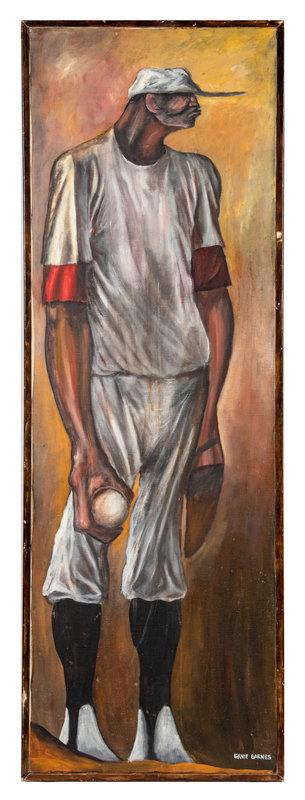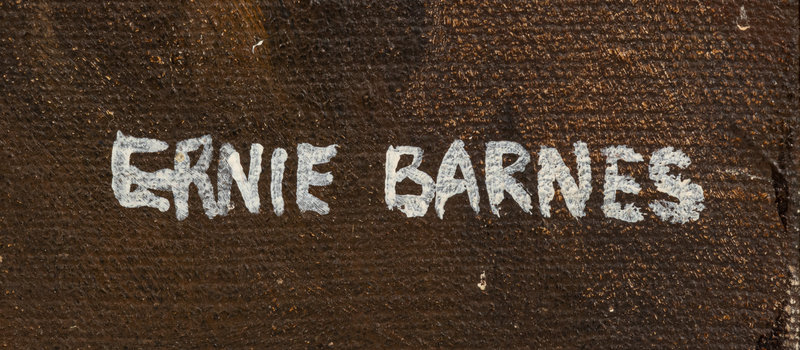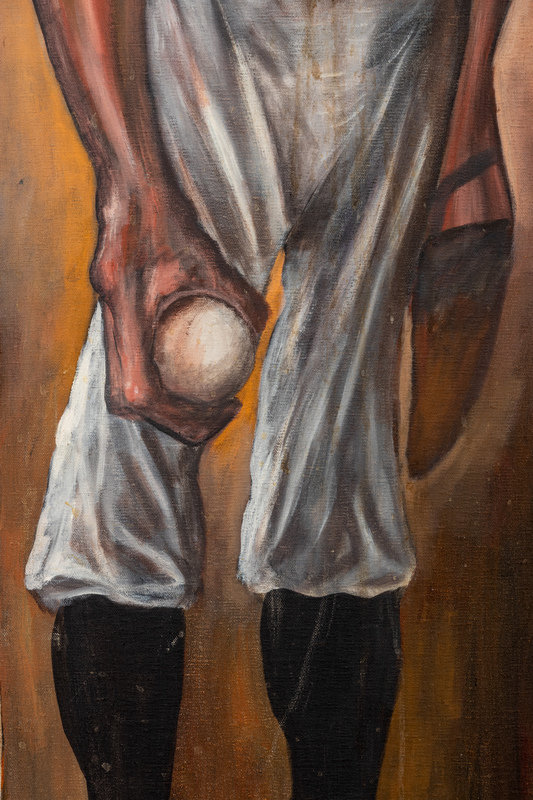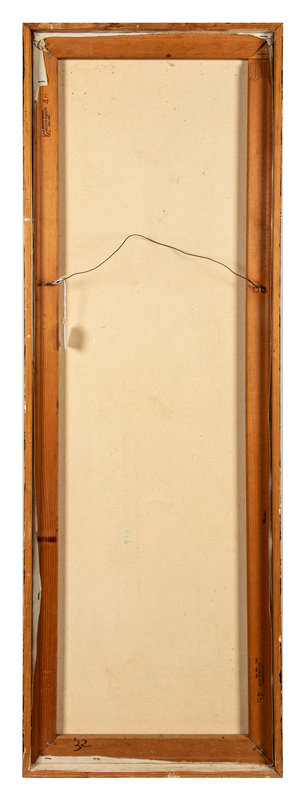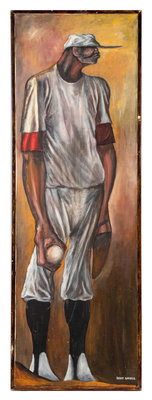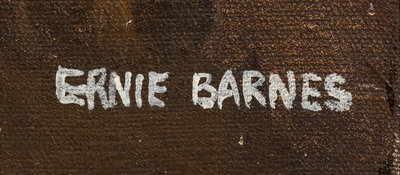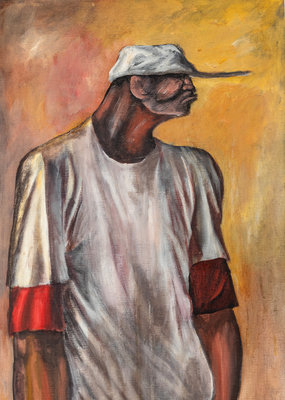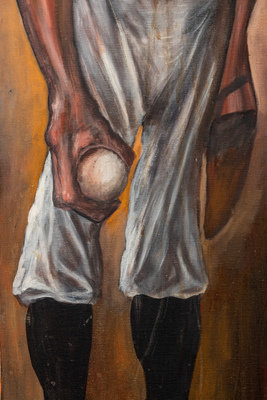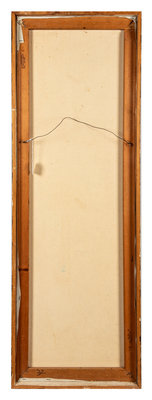Lot 50
Ernie Barnes, Jr.
(American, 1938-2009)
Untitled (The Stare)
Sale 1058 - Post-War & Contemporary Art
Sep 28, 2022
10:00AM CT
Live / Chicago
Own a similar item?
Estimate
$80,000 -
120,000
Price Realized
$312,500
Sold prices are inclusive of Buyer’s Premium
Lot Description
Ernie Barnes, Jr.
(American, 1938-2009)
Untitled (The Stare)
oil on canvas
signed Ernie Barnes (lower right)
48 x 16 inches.
The Ernie Barnes Foundation has confirmed that the present lot will be included in the forthcoming catalogue raisonné on the artist.
Lot Essay:
Ernie Knows Painting
“One day on the playing field, I looked up and the sun was breaking through the clouds, hitting the unmuddied areas on the uniforms, and I said, ‘that’s beautiful!’ I knew then that it was all over being a player. I was more interested in art. So I traded my cleats for canvas, my bruises for brushes, and put all the violence and power I had felt on the field into my paintings.” -Ernie Barnes Jr.
Decades before Nike and Bo Jackson would make the notion of the multitool athlete Renaissance man a commercial catchphrase, artist, athlete, author, television show creator and actor Ernie Barnes Jr. achieved his own pop culture celebrity for his varied areas of expert knowledge and most importantly for knowing painting. Barnes Denver Bronco teammates even nicknamed him “Big Rembrandt” for his habit of sketching during team meetings, frequently drawing fines for focusing on the wrong practice, unaware that he aptly shared a birthday with the Dutch Master. Despite having the talent to play football professionally and earning a living doing so, Barnes’ heart was never fully in that aspect of the game and he would retire from the sport in 1965 after playing five seasons in the National and Canadian Football Leagues to turning his attention to art making, the skill set that held his true passion. Barnes who is arguably most recognized for his stylized and evocative paintings of athletes and credited his time as a player with informing how he uniquely depicted bodies in motion, would later address his conflicted emotions about sports in a series of illustrated essays called I Hate the Game I Love. These musing also served as the foundation for his later autobiography From Pads to Pallete that further expounded on his internal struggle during his professional transitioned from athlete to artist.
A student of art history since early childhood, Ernie Barnes most direct inspiration came from the Late Renaissance painters, the influence of El Grecco can be seen in his interest in elongated limbs, exaggerated movement and highlighted fabric folds, earning him critical classification as a Neo-Mannerist for his contemporary approach to this classical mode of representation. In concept and content nostalgic episodic explorations of the African American experience are the common thread throughout Barnes work. Whether set on the ballfield, the court, the dancefloor, the pew, the stage or the street corner, these poetic snapshots of the realities of life in his communities remained a constant in his paintings, dually celebrating black cultural aesthetics while subtly yet effectively expressing the sorrow of systemic racial inequality through the filter of Barnes unique and raw brand of Black Romanticism. Barnes mostly directly and poignantly addressed these vital themes in his ambitious seven-year 35 painting traveling exhibition The Beauty of the Ghetto that toured American cities from 1972 to 1977 and introduced his vision to thousands of eyes countrywide. As widespread as this attention was it was fractional in comparison to the exposure his paintings would receive as central plot points in the Norman Lear situation comedy Good Times as Barnes painted the majority of the works attributed to fictional artist J.J. “Kid Dynomite” Evans on the show and also played a minor recurring character appearing in several episodes. His masterpiece Sugar Shack, that also appeared on Marvin Gaye’s 1976 Motown Classic I Want You, was also the focal point of the opening and end credits on later seasons of Good Times.
The presently offered Untitled (The Stare) concisely captures all of the painterly pitches in Barnes arsenal resulting in a powerful moment of beautiful blackness on a sunlit field. The painting depicts a solitary statuesque baseball pitcher, sentinel between throws, checking the signs from his catcher or icily staring down his next strikeout victim. His lanky yet muscular right arm stretches dramatically downward to a talon like hand purposefully clutching the baseball poised for propulsion. The modeled sinews in his prone forearm a rich chocolate against the punch of his red quarter sleeve also echo the gathered wrinkles in his baggy away gray uniform. His cleats planted firmly below him obscured by the abstracted suggestion of the mound, above an elongated hat bill extends to the edge of the canvas directing the viewer’s gaze off frame to the target of his narrowed eyes. It is noteworthy that the pitcher is staring as Barnes typically represents his subject with their eyes closed to symbolize a general societal blindness to the humanity of others, in this instance the concentrated squint of hurler reflects a willingness to challenge that blindness by throwing everything in his repertoire at it. He looks determined, there is a quiet anger to him. This could be the fire of competition or if the 1940s style of his glove and uniform are an indication it is the frustration of an athlete relegated to an underfunded segregated league or the righteous defiance of a player who has bravely crossed the color barrier into the majors. Although Barnes usually painted anonymous emblematic figures the associative physical similarities of this baseballer to Hall of Famer and the first African American to pitch in the World Series, Satchel Paige, cannot be escaped, right down to mitt position of the pre windup stance. This painting is perhaps prescient that Barnes would later play slugger Josh Gibson in the biopic Don’t Look Back covering five decade spanning career in the Negro and Major League. Untitled (The Stare) is importantly housed in a raw wood slat frame, a Barnes hallmark and an homage to the artist’s father who died weeks before his first solo exhibit opened in 1966, referencing to the wooden fence his father built to surround the family home and connecting the elder to each painting the younger produced. From this frame inward, the work is multifaceted, and it is this layered depth of meaning that make it so impressive and unique, like a perfect game tossed by the ace of the rotation, an absolute gem, rarely seen
Condition Report
Contact Information
Auction Specialist

